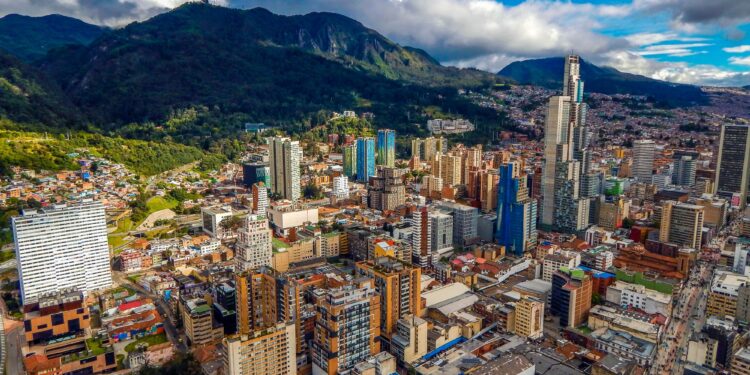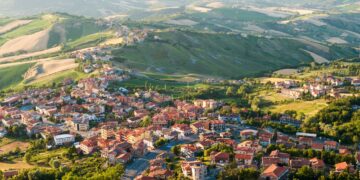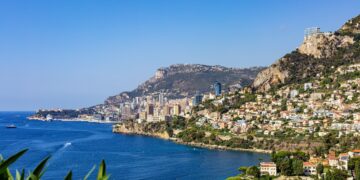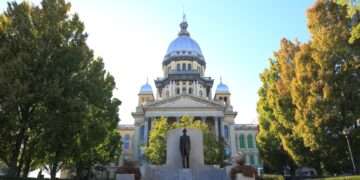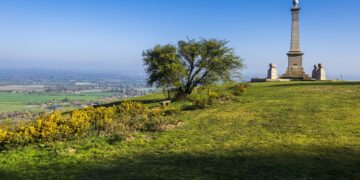A journey through Colombia, a country steeped in history, culture, and natural beauty, is like walking through the sets of countless films, TV shows, and literary works. From the rolling hills of the Andean region to the bustling streets of Bogotá, Colombia’s diverse landscapes have served as the backdrop for many cinematic and literary masterpieces. So, get ready for an unforgettable journey through Colombia’s cinematic landscape!
10 Famous Films Shot in Colombia
Colombia, with its diverse natural landscapes, vibrant cities, and rich cultural heritage, has always been a popular choice for filmmakers from around the world. Here are ten films that have captured the essence of this fascinating country:
- Romancing the Stone (1984): Although set in Colombia, this adventurous romantic comedy was not filmed in Colombia. However, it did use the country’s exotic reputation to set the stage for its thrilling narrative.
- Clear and Present Danger (1994): This adaptation of Tom Clancy’s novel showcases various Colombian locations, including the capital city, Bogotá.
- The Mission (1986): This historical drama about the experiences of a Jesuit missionary in 18th-century South America was filmed in the natural parks near the border with Brazil.
- Love in the Time of Cholera (2007): Filmed in the historic city of Cartagena, this film adaptation of Gabriel García Márquez’s novel captures the romantic essence of the Colombian Caribbean.
- Maria Full of Grace (2004): This Oscar-nominated film provides a stark portrayal of drug trafficking in Colombia, with scenes shot in Bogotá.
- The Two Escobars (2010): This acclaimed documentary explores the lives of drug lord Pablo Escobar and footballer Andrés Escobar, set against the backdrop of Colombian society.
- Embrace of the Serpent (2015): Colombia’s first Oscar-nominated film, this black and white masterpiece was shot in the Amazon rainforest.
- The Wind Journeys (2009): This film takes viewers on a journey through the stunning landscapes of northern Colombia, showcasing the region’s unique musical traditions.
- Birds of Passage (2018): Set in the Guajira Desert, this film tells the story of the indigenous Wayuu people during the early days of the drug trade.
- Monos (2019): Shot in the high-altitude Andean region and the dense jungle, this film presents a visually stunning yet disturbing depiction of guerilla warfare.
These movies offer a glimpse into Colombia’s multi-faceted beauty and its complex societal issues, making it a compelling setting for a wide range of cinematic narratives.
5 TV Shows Set in Colombia
Colombia’s rich cultural tapestry and picturesque settings have also made it an ideal location for a variety of TV shows. Here are five shows that capture the essence of this vibrant country:
- Narcos (2015-2017): This popular Netflix series delves into the life of infamous drug lord Pablo Escobar and the history of drug trafficking in Colombia.
- Colombia’s Wild Magic (2015): This documentary series explores the diverse ecosystems of Colombia, from its snow-capped mountains to its tropical rainforests.
- Tres Caínes (2013): This Colombian series offers a dramatic portrayal of the Castaño brothers, who played a significant role in the country’s armed conflict.
- The Queen of Flow (2018-present): This telenovela, set and filmed in Medellín, tells the story of a talented songwriter seeking revenge against those who wronged her.
- Surviving Escobar (2017): Also known as “Surviving Escobar: Alias J.J.,” this series follows the life of John Jairo Velásquez Vásquez, a hitman for the Medellín Cartel, after the death of Pablo Escobar.
These series highlight the diversity of Colombia’s landscapes and society, providing viewers with a nuanced portrayal of life in this Latin American nation.
5 Animated Films Set in Colombia
In addition to live-action films and TV shows, Colombia’s rich culture and stunning landscapes have also inspired several animated films. Here are five animated films set in the country:
- The Gold of the Condor (2000): This Colombian film tells the story of a boy’s journey to retrieve the sacred gold of his tribe from the conquistador who stole it.
- Pequeñas Voces (2010): A powerful documentary-style animated film that presents the harsh reality of Colombia’s armed conflict through the eyes of children.
- Gordo, calvo y bajito (2012): This Colombian film follows the life of a man who, despite his insecurities, learns to accept himself.
- Sabogal (2015): This Colombian animated series explores the political and social issues of the country through the eyes of a detective.
- Encanto (2021): This upcoming Disney film is set in a magical version of Colombia and is expected to showcase the country’s culture and music.
These animated features celebrate Colombia’s unique blend of culture, history, and natural beauty, providing audiences with engaging stories and stunning visuals.
Famous Books Set in Colombia: Classic and Contemporary
Colombia, known for its lush landscapes, multicultural cities, and complex history, has provided a vibrant backdrop for many literary works. Here are three classic and three contemporary books that bring the spirit of this South American country to life:
Classic:
- One Hundred Years of Solitude (1967) by Gabriel García Márquez: This iconic novel offers a magical portrayal of the fictional town of Macondo, believed to be inspired by Márquez’s hometown, Aracataca.
- Love in the Time of Cholera (1985) by Gabriel García Márquez: Set in the historic city of Cartagena, this novel explores love and passion in the time of cholera.
- The General in His Labyrinth (1989) by Gabriel García Márquez: This historical novel depicts the last days of Simón Bolívar, the liberator of Colombia.
Contemporary:
- Out of the Dark (1995) by Juan Gabriel Vásquez: This contemporary novel explores the impact of drug trafficking on Colombian society.
- The Sound of Things Falling (2011) by Juan Gabriel Vásquez: This novel delves into the personal and societal effects of the drug trade in Bogotá during the 20th century.
- Reputations (2013) by Juan Gabriel Vásquez: This acclaimed novel examines the power of public opinion and its influence on personal identity.
These books, both classic and contemporary, encapsulate various aspects of Colombia’s multifaceted persona, providing readers with a deeper understanding of its rich culture and complex history.
Exploring Colombia Filming Locations – Where to Go
If you’re eager to experience Colombia’s cinematic landscapes firsthand, here are some essential filming locations to visit:
- Cartagena: This historic city, known for its colonial architecture and Caribbean charm, was the backdrop for “Love in the Time of Cholera” and many other films and TV shows.
- Bogotá: The capital city of Colombia, with its mix of modern and colonial architecture, has been featured in films like “Clear and Present Danger” and TV shows like “Narcos”.
- Medellín: The city’s transformation from a drug cartel hotspot to a vibrant metropolis is captured in TV shows like “Narcos” and “Surviving Escobar”.
- Guajira Desert: The stunning landscapes of this desert, as well as the indigenous Wayuu culture, are prominently featured in “Birds of Passage”.
- Amazon Rainforest: The lush, remote regions of the Amazon are used to depict the isolation and mystery of the jungle in films like “Embrace of the Serpent”.
Exploring these filming locations offers an exciting blend of entertainment and sightseeing, allowing visitors to engage with the country’s film heritage while enjoying its many cultural and natural attractions.
Where to Sleep in Colombia: Cheap and Luxury
Colombia offers a diverse range of accommodations, from budget hostels to luxury hotels. Here are three budget-friendly and three luxury options to consider:
Budget-Friendly:
- Masaya Hostel Bogotá: Located in the historic La Candelaria district, this hostel offers comfort, culture, and affordability in the heart of the city.
- The Clock Hostel & Suites in Cartagena: This modern hostel is a great choice for budget travelers, offering a central location and a rooftop pool.
- Happy Buddha Boutique Hostel in Medellín: This friendly hostel offers comfortable rooms, social events, and a convenient location in the trendy El Poblado district.
Luxury:
- Sofitel Legend Santa Clara Cartagena: This luxury hotel, set in a former convent, offers a blend of colonial architecture and modern comfort.
- Four Seasons Hotel Bogotá: This luxury boutique hotel in the Zona Rosa district offers opulent rooms, a high-end spa, and gourmet dining.
- Hotel Quadrifolio in Cartagena: This luxury hotel offers a peaceful retreat in the heart of the city, with spacious rooms and a rooftop pool.
Whether you prefer the budget-friendly hostels or the luxury hotels, each accommodation option offers a unique way to experience Colombia’s vibrant cities.
Where to Eat in Colombia: 3 Budget and 3 Luxury
Colombia’s culinary scene is as diverse as its landscapes, offering everything from street food staples to high-end dining experiences. Here are three budget-friendly and three luxury dining options:
Budget-Friendly:
- La Puerta Falsa in Bogotá: This historic restaurant is famous for its traditional Colombian dishes like tamales and hot chocolate with cheese.
- Cevichería Trattoria Donde Wippy in Cartagena: This small eatery offers delicious and affordable seafood dishes.
- Hacienda Junín in Medellín: This coffee shop offers a chance to try Colombia’s world-famous coffee at a reasonable price.
Luxury:
- Leo in Bogotá: This award-winning restaurant offers a unique tasting menu that explores Colombia’s biodiversity.
- Carmen in Medellín: This high-end restaurant offers innovative dishes that combine Colombian flavors with international techniques.
- Marea by Rausch in Cartagena: This upscale restaurant offers a gourmet sea-to-table experience with stunning views of the Caribbean Sea.
Whether you’re after a casual bite or a gourmet dining experience, Colombia’s culinary scene offers something for every palate and budget.
Detailed Itinerary Day by Day
Experience the cinematic landscapes of Colombia with this detailed 7-day itinerary:
Day 1 – Bogotá: Start your journey in Colombia’s capital, Bogotá. Explore the historic La Candelaria district and visit the famous Gold Museum. In the afternoon, take a cable car to the top of Monserrate to enjoy panoramic views of the city.
Day 2 – Zipaquirá and Guatavita: Take a day trip to the nearby Salt Cathedral of Zipaquirá, a unique underground church built within a salt mine. In the afternoon, visit the town of Guatavita and learn about the legend of El Dorado.
Day 3 – Medellín: Fly to Medellín and explore the city’s transformation by visiting the Comuna 13 neighborhood. In the evening, enjoy the city’s vibrant nightlife in the El Poblado district.
Day 4 – Guatapé: Take a day trip to Guatapé, where you can climb the 740 steps of El Peñón de Guatapé for stunning views of the surrounding lakes. Explore the colorful town of Guatapé in the afternoon.
Day 5 – Cartagena: Fly to Cartagena and spend the day exploring the city’s historic walled city, filled with colonial architecture and vibrant plazas.
Day 6 – Rosario Islands: Take a boat trip to the Rosario Islands, where you can relax on the beach, snorkel in the clear waters, and enjoy fresh seafood.
Day 7 – Cartagena: Spend your last day in Colombia exploring more of Cartagena. Visit the imposing San Felipe Castle, explore the Getsemaní neighborhood, and end your day with a sunset drink at Café del Mar.
This itinerary offers a balance of city explorations, historical sites, and natural beauty, providing a comprehensive overview of Colombia’s diverse landscapes and rich culture.
Cryptid Legends and Curiosities
Colombia, with its rich folklore and diverse ecosystems, is home to a myriad of cryptid legends and curiosities. From the Andean region to the Amazon rainforest, tales of mythical creatures and unexplained phenomena abound.
One of the most famous cryptid legends in Colombia is the “El Mohán,” a mischievous creature believed to live near rivers and lakes. It’s said to lure fishermen and travelers with its enchanting music and tricks. Meanwhile, in the depths of the Amazon rainforest, tales of the “Yuruparí,” a half-human, half-serpent deity revered by the indigenous communities, add an element of mystery and reverence to this biodiverse region.
These legends, deeply rooted in Colombia’s indigenous cultures and passed down through generations, add a layer of intrigue to the country’s cinematic landscapes. They invite visitors to delve deeper into Colombia’s rich cultural heritage and explore the country beyond its physical beauty.
Hidden Gems in Colombia
Beyond the well-trodden paths, Colombia hides a treasure trove of lesser-known locations that are cinematic in their own right. From remote desert landscapes to vibrant cultural districts, these hidden gems offer a unique glimpse into the country’s diverse beauty.
Tatacoa Desert: This arid landscape, characterized by its eroded cliffs and red sands, offers a stark contrast to the lush greenery often associated with Colombia. It’s a perfect location for dramatic desert scenes.
Chocó Department: This biodiverse region, home to Afro-Colombian and indigenous communities, is known for its pristine beaches, dense rainforest, and the incredible humpback whale watching opportunities.
Cali’s Salsa Clubs: The city of Cali, known as the salsa capital of the world, offers an electrifying nightlife scene that’s often overlooked by tourists. The city’s salsa clubs, pulsating with energy and rhythm, offer a vivid setting for dance-themed movies.
Los Estoraques Unique Natural Area: This lesser-known natural park, with its unique rock formations and desert-like landscapes, offers a picturesque setting for adventure and fantasy films.
Exploring these hidden gems in Colombia not only provides a unique cinematic experience but also offers a deeper understanding of the country’s diverse landscapes and cultures.
What to Pack for a Trip to Colombia
Whether you’re planning to explore the historic streets of Cartagena, the bustling city life of Bogotá, or the remote regions of the Amazon rainforest, packing for a trip to Colombia requires careful consideration. Here’s what to pack:
- Clothing: Pack lightweight clothing for the tropical coastal areas, and warmer clothing for Bogotá and the Andean region. Don’t forget a waterproof jacket for the rainy season and areas like the Amazon.
- Footwear: Comfortable walking shoes are essential for exploring Colombia’s cobblestone streets and hiking in its national parks.
- Accessories: Pack a hat, sunglasses, and sunscreen for protection against the sun. A reusable water bottle is also handy to stay hydrated during your adventures.
- Health Essentials: Pack a basic first aid kit, any necessary medications, and insect repellent, especially if you plan to visit the Amazon region.
- Other Essentials: Don’t forget your camera to capture the country’s stunning landscapes and cityscapes, and a good book for those relaxing beach days or long bus journeys.
Remember, it’s always a good idea to check the weather forecast before your trip to ensure you’re packing the right items for the current weather conditions.
Transportation Tips for Getting Around Colombia
Getting around Colombia can be an adventure in itself, with various options available depending on your destination and comfort level. Here are some transportation tips for exploring Colombia’s cinematic locations:
Air Travel: With several domestic airlines operating frequent flights, air travel is the quickest way to get around Colombia, especially for long distances.
Buses: For short to medium distances, buses are a cost-effective option. They range from basic public buses to luxury coaches with reclining seats and Wi-Fi.
Taxis and Ride-Sharing: In cities, taxis and ride-sharing services like Uber are widely available. Always make sure to negotiate the fare beforehand or ensure the meter is running.
Rental Cars: Renting a car provides the most flexibility to explore at your own pace. However, be prepared for challenging driving conditions, especially in rural areas.
Bicycles: In cities like Bogotá and Medellín, bicycles are a popular mode of transport. Many cities also have dedicated cycle lanes and bike rental schemes.
Whether you choose to fly, take a bus, or rent a car, each mode of transport offers unique perspectives of Colombia’s diverse landscapes.
Travel Documents Needed for Visiting Colombia
Before setting off on your cinematic journey through Colombia, ensure you have the necessary travel documents:
- Passport: A passport valid for at least six months beyond your planned departure date is required.
- Visa: Depending on your nationality, you may need a visa to enter Colombia. However, many countries, including the U.S., Canada, Australia, and most of Europe, are allowed a visa-free stay of up to 90 days.
- Proof of Onward Travel: You may be asked to show proof of onward travel, such as a return or onward flight ticket.
- Travel Insurance: While not a requirement, travel insurance that covers medical expenses, trip cancellation, and lost luggage is highly recommended.
Remember to check the specific entry requirements for your home country before your trip to ensure a smooth journey to Colombia.
Conclusion: Your Ultimate Colombia Film Tour Guide
Embarking on a cinematic tour of Colombia is like stepping into a real-life movie set. From exploring the locations of 10 famous films shot in Colombia to discovering the hidden gems that make this country a filmmaker’s paradise, you’ll experience the magic of the silver screen while immersing yourself in Colombia’s rich culture and stunning landscapes. Whether you’re a film buff, a literature enthusiast, or a curious traveler, this comprehensive guide provides all the information you need for your ultimate Colombia film tour. So pack your bags, roll the camera, and get ready to step into the spotlight!


